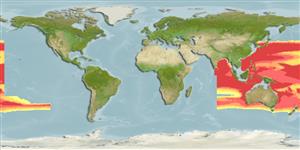Common names from other countries
>
Aulopiformes (Grinners) >
Lestidiidae (Naked barracudinas)
Etymology: Lestrolepis: Greek, lestris, -idos = bandit + Greek,lepis = scale (Ref. 45335).
More on author: Tanaka.
Environment: milieu / climate zone / depth range / distribution range
экология
морской. Subtropical
Western Pacific: widespread; with confirmed records from Japan, Taiwan, the Philippines, nw Australia and the South China Sea.
Size / Вес / Возраст
Maturity: Lm ? range ? - ? cm
Max length : 22.2 cm TL самец/пол неопределен; (Ref. 121637); наибольший возраст (опубликованны данные): 4 годы (Ref. 50621)
Краткое описание
определительные ключи | морфология | морфометрия
членистые (мягкие) лучи спинного плавника (общее число) : 9; членистые (мягкие) лучи анального плавника: 36 - 40; позвонки: 82 - 88. This moderately elongate species is distinguished by the following: body depth 13-16 times in SL; dorsal-fin origin clearly before midline of horizontal distance between origins of pelvic (ventral) and anal fins (V-A), origins of pelvic and dorsal fins (V–D) 32.5-43.1% V–A; A 36-40; vertebrae: prehaemal 30-32, prepelvic 30-33, predorsal 36-40, preanal 48-51, caudal 52-58; and total 82-88; total lateral-line scales 66-72; with a narrow band of black chromatophores along lower portion of abdominal ridge (Ref. 121637).
Mesopelagic species (Ref. 7300, 75154). Feeds on small fishes rather than shrimps (Ref. 121637).
Synchronous hermaphrodite (Ref. 84976).
Ho, H.-C., S.-Y. Tsai and H.-H. Li, 2019. The barracudina genera Lestidium and Lestrolepis of Taiwan, with descriptions of two new species (Aulopiformes: Paralepididae). Zootaxa 4702(1):114-139. (Ref. 121637)
Статус Красного Списка МСОП (Ref. 130435)
CITES (Ref. 128078)
Not Evaluated
Угроза для людей
Harmless
Использование человеком
дополнительная информация
инструменты
Специальные отчеты
Скачать в формате XML
ресурсы в Интернет
Estimates based on models
Preferred temperature (Ref.
115969): 7.4 - 14.8, mean 9.8 (based on 296 cells).
Phylogenetic diversity index (Ref.
82804): PD
50 = 0.6250 [Uniqueness, from 0.5 = low to 2.0 = high].
Bayesian length-weight: a=0.00219 (0.00088 - 0.00547), b=3.08 (2.86 - 3.30), in cm Total Length, based on LWR estimates for this (Sub)family-body shape (Ref.
93245).
Trophic level (Ref.
69278): 4.1 ±0.6 se; based on size and trophs of closest relatives
устойчивость к внешним воздействиям (Ref.
120179): средний (среднего размера), минимальное время удвоения популяции 1.4-4.4 года (tm=4; k >0.3; Fec=300-500 (batch fecundity)).
Fishing Vulnerability (Ref.
59153): Low vulnerability (12 of 100).
